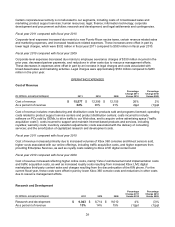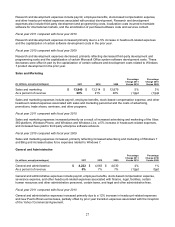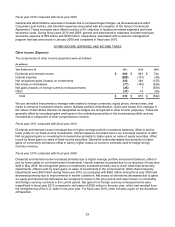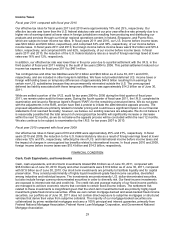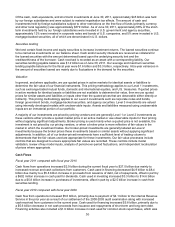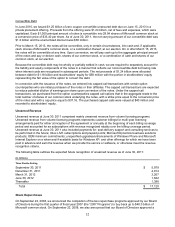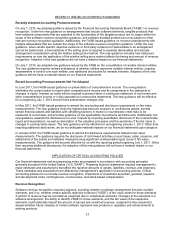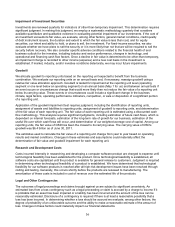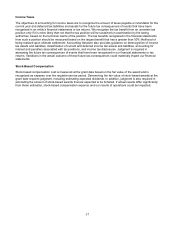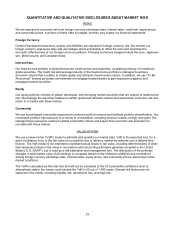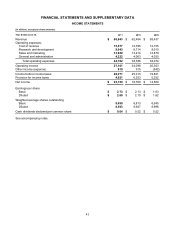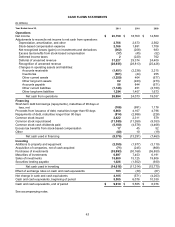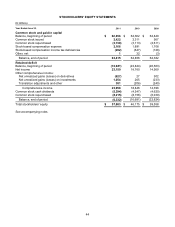Microsoft 2011 Annual Report Download - page 35
Download and view the complete annual report
Please find page 35 of the 2011 Microsoft annual report below. You can navigate through the pages in the report by either clicking on the pages listed below, or by using the keyword search tool below to find specific information within the annual report.
35
RECENTLY ISSUED ACCOUNTING STANDARDS
Recently Adopted Accounting Pronouncements
On July 1, 2010, we adopted guidance issued by the Financial Accounting Standards Board (“FASB”) on revenue
recognition. Under the new guidance on arrangements that include software elements, tangible products that
have software components that are essential to the functionality of the tangible product are no longer within the
scope of the software revenue recognition guidance, and software-enabled products are now subject to other
relevant revenue recognition guidance. Additionally, the FASB issued guidance on revenue arrangements with
multiple deliverables that are outside the scope of the software revenue recognition guidance. Under the new
guidance, when vendor specific objective evidence or third party evidence for deliverables in an arrangement
cannot be determined, a best estimate of the selling price is required to separate deliverables and allocate
arrangement consideration using the relative selling price method. The new guidance includes new disclosure
requirements on how the application of the relative selling price method affects the timing and amount of revenue
recognition. Adoption of the new guidance did not have a material impact on our financial statements.
On July 1, 2010, we adopted new guidance issued by the FASB on the consolidation of variable interest entities.
The new guidance requires revised evaluations of whether entities represent variable interest entities, ongoing
assessments of control over such entities, and additional disclosures for variable interests. Adoption of the new
guidance did not have a material impact on our financial statements.
Recent Accounting Pronouncements Not Yet Adopted
In June 2011, the FASB issued guidance on presentation of comprehensive income. The new guidance
eliminates the current option to report other comprehensive income and its components in the statement of
changes in equity. Instead, an entity will be required to present either a continuous statement of net income and
other comprehensive income or in two separate but consecutive statements. The new guidance will be effective
for us beginning July 1, 2012 and will have presentation changes only.
In May 2011, the FASB issued guidance to amend the accounting and disclosure requirements on fair value
measurements. The new guidance limits the highest-and-best-use measure to nonfinancial assets, permits
certain financial assets and liabilities with offsetting positions in market or counterparty credit risks to be
measured at a net basis, and provides guidance on the applicability of premiums and discounts. Additionally, the
new guidance expands the disclosures on Level 3 inputs by requiring quantitative disclosure of the unobservable
inputs and assumptions, as well as description of the valuation processes and the sensitivity of the fair value to
changes in unobservable inputs. The new guidance will be effective for us beginning January 1, 2012. Other than
requiring additional disclosures, we do not anticipate material impacts on our financial statements upon adoption.
In January 2010, the FASB issued guidance to amend the disclosure requirements related to fair value
measurements. The guidance requires the disclosure of roll forward activities on purchases, sales, issuance, and
settlements of the assets and liabilities measured using significant unobservable inputs (Level 3 fair value
measurements). The guidance will become effective for us with the reporting period beginning July 1, 2011. Other
than requiring additional disclosures, the adoption of this new guidance will not have a material impact on our
financial statements.
APPLICATION OF CRITICAL ACCOUNTING POLICIES
Our financial statements and accompanying notes are prepared in accordance with accounting principles
generally accepted in the United States (“U.S. GAAP”). Preparing financial statements requires management to
make estimates and assumptions that affect the reported amounts of assets, liabilities, revenue, and expenses.
These estimates and assumptions are affected by management’s application of accounting policies. Critical
accounting policies for us include revenue recognition, impairment of investment securities, goodwill, research
and development costs, contingencies, income taxes, and stock-based compensation.
Revenue Recognition
Software revenue recognition requires judgment, including whether a software arrangement includes multiple
elements, and if so, whether vendor-specific objective evidence (“VSOE”) of fair value exists for those elements.
A portion of revenue may be recorded as unearned due to undelivered elements. Changes to the elements in a
software arrangement, the ability to identify VSOE for those elements, and the fair value of the respective
elements could materially impact the amount of earned and unearned revenue. Judgment is also required to
assess whether future releases of certain software represent new products or upgrades and enhancements to
existing products.



